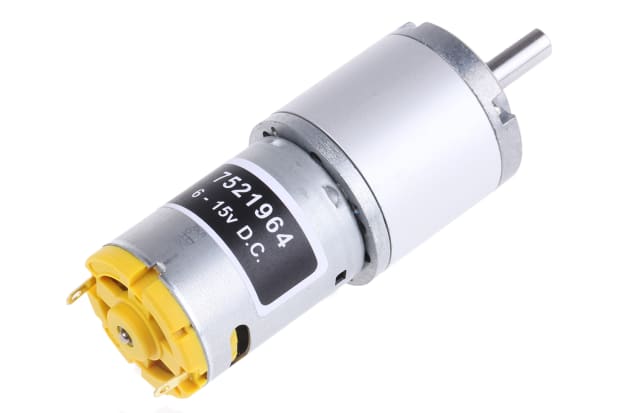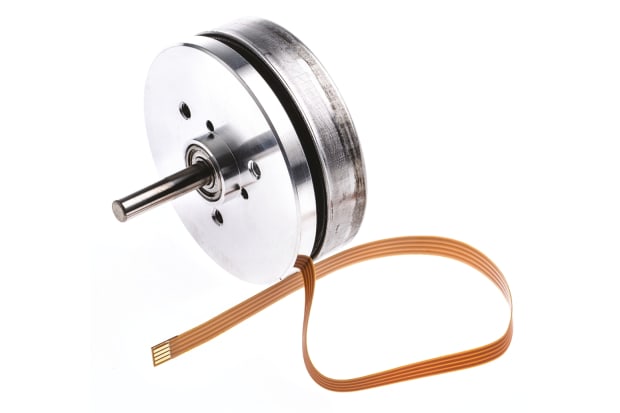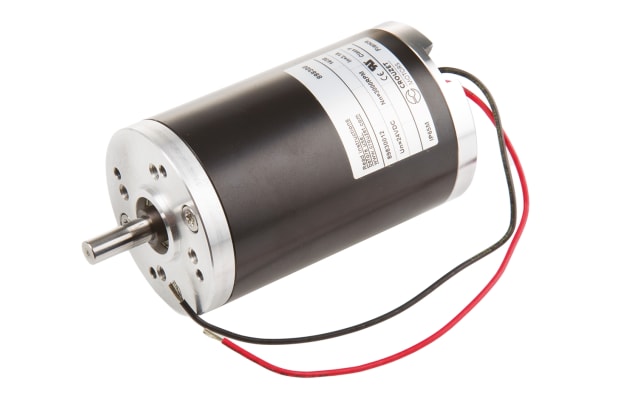- Published 10 Jan 2023
- Last Modified 29 Aug 2023
- 10 min
The Complete Guide to DC Motors

This guide is part of our Industrial Automation hub where you can discover more about AI, automation and control.
This guide is designed to provide in-depth information on all things related to DC motors, including how these mechanisms work, who pioneered the DC motor, the various types of motor available, and the numerous applications of these components.
What is a DC Motor?
A direct current (DC) motor is a type of electric machine that converts electrical energy into mechanical energy. DC motors take electrical power through direct current, and convert this energy into mechanical rotation.
DC motors use magnetic fields that occur from the electrical currents generated, which powers the movement of a rotor fixed within the output shaft. The output torque and speed depends upon both the electrical input and the design of the motor.
How DC motors work

The term ‘DC motor’ is used to refer to any rotary electrical machine that converts direct current electrical energy into mechanical energy. DC motors can vary in size and power from small motors in toys and appliances to large mechanisms that power vehicles, pull elevators and hoists, and drive steel rolling mills. But how do DC motors work?
DC motors include two key components: a stator and an armature. The stator is the stationary part of a motor, while the armature rotates. In a DC motor, the stator provides a rotating magnetic field that drives the armature to rotate.
A simple DC motor uses a stationary set of magnets in the stator, and a coil of wire with a current running through it to generate an electromagnetic field aligned with the centre of the coil. One or more windings of insulated wire are wrapped around the core of the motor to concentrate the magnetic field.
The windings of insulated wire are connected to a commutator (a rotary electrical switch), that applies an electrical current to the windings. The commutator allows each armature coil to be energised in turn, creating a steady rotating force (known as torque).
When the coils are turned on and off in sequence, a rotating magnetic field is created that interacts with the differing fields of the stationary magnets in the stator to create torque, which causes it to rotate. These key operating principles of DC motors allow them to convert the electrical energy from direct current into mechanical energy through the rotating movement, which can then be used for the propulsion of objects.
Who invented the DC motor?
This amazing piece of electrical equipment has revolutionised our lives in many ways, but who invented the DC motor? As with all major innovations, there are many people who had a role to play through the development of similar mechanisms.
In the US, Thomas Davenport is widely celebrated as the inventor of the first electric motor, and undoubtedly he was the first to patent a useable electric motor in 1837. Davenport, however, was not the first person to build an electric motor, with various inventors in Europe having already developed more powerful versions by the time Davenport filed his patent.
In 1834, Moritz Jacobi had presented a motor that was three times as powerful as the one Davenport would later patent, while Sibrandus Stratingh and Christopher Becker were the first to demonstrate a practical application for an electric motor, by running a small model car in 1835.
The first practical DC motor was invented some years later in 1886 by Frank Julian Sprague, whose invention lead to the first motor powered trolley system in 1887, and the first electric elevator in 1892. Sprague’s DC motor was a hugely significant development, leading to a variety of applications which would reshape the face of industry and manufacturing.
Types of DC Motors
So far, this guide has broadly explained how DC motors work, the history of these mechanisms, and what they look like. While the principles are the same across variants, there are actually several different types of DC motors, which offer specific advantages and disadvantages over each other.
This section of the guide will look at the four main types of DC motor - brushless, brushed, shunt, and series.

Brushless DC motors
Shop for brushless DC motorsWhat is a brushless DC motor?
Brushless DC motors are also known as electronically commutated motors, or synchronous DC motors, and differ to the brushed motor, thanks to the development of solid state electronics.
The key differences between brushless DC motors and other varieties is that they do not have a commutator, which is replaced by an electronic servomechanism that is able to detect and adjust the angle of the rotor.
The brushless DC motor has several advantages. Commutators use soft contacts called ‘brushes’ which wear down over time. A brushless DC motor is therefore more durable, and also safer than the more classical design.
How does a brushless DC motor work?
All electric motors develop torque by alternating the polarity of rotating magnets attached to the rotor and stationary magnets on the surrounding stator. At least one of these set of magnets is an electromagnet, made from a coil of wire around an iron core.
In a DC motor, DC running through the wire winding creates the magnetic field. Each time the armature rotates by 180°, the position of the north and south poles are reversed. If the magnetic field of the poles remained the same, the rotor would not turn. To create torque in one direction in a DC motor, the direction of the electric current must be reversed with every 180° turn of the armature.
In a traditional brushed motor, this would be done by a commutator, but in a brushless DC motor, an electronic sensor instead detects the angle of the rotor, with controlled semiconductor switches either reversing the direction of the current or turning it off at the correct time in the rotation to create torque in one direction.

Brushed DC motors
Shop for brushed DC motorsWhat is a brushed DC motor?
The brushed DC motor is the original DC motor, dating back to Sprague’s initial design. As we have discussed already in this guide, the classic brushed motor features a commutator, to reverse the current every half cycle and create single direction torque.
While brushed DC motors remain popular for electrical propulsion, cranes, paper machines, and steel rolling mills, many have been phased out for the more efficient brushless model in recent years.
How does a brushed DC motor work?
As has been explained in this guide already, brushed DC motors utilise soft contacts known as ‘brushes’ to ensure the motor rotates in one direction. Brushed motors’ speed can be varied by the operating voltage or the strength of the magnetic field.
There are a few different varieties of brushed DC motors, which differ depending on the connection to the armature, which will be discussed in the following sections.

What is a shunt DC motor?
A DC shunt motor is a variety of brushed motor that has field windings connected in parallel with the armature. Shunt wound DC motors have a lower current because of the parallel windings.
A shunt motor is used for applications that require a constant torque, where the load is not significantly altered by speed, such as conveyor belts, mixers and hoists.
The specific field windings provide unique shunt motor characteristics that make it such an effective choice for constant torque applications. Many shunt DC motors feature constant speed characteristics, with the small difference between no-load and full-load speed the main benefit of this type of motor.

What is a series DC motor?
Series wound DC motors are the final variety of brushed motors in this guide. The key difference between this variety and the shunt motors discussed previously is that field windings are connected in a series. This means that the entire armature current passes to the field winding, creating much faster speeds.
As the supply voltage can’t be adjusted, series DC motors can’t regulate their speed particularly well.
While this is a problem for some applications, it makes them particularly useful for tasks that require high starting torque, such as power tools and sewing machines.
The specific characteristics of DC series motors offers a clear and distinct purpose. The Aulhaber Brushed DC Geared motor is a good example of the benefits of series wound motors, having high starting torque that is ideal for appliances.
Applications of DC motors
Thanks to the different types of DC motors available, there are a wide variety of applications for DC motors. The previous section considered some of the various applications and circumstances where DC motors are used, and the benefits of the various types of motor.
While each type has its advantages, broadly speaking, there are various uses of a DC motor. At home, small DC motors are used in tools, toys and various household appliances. In retail, the applications of DC motors include conveyors and turntables, while in an industrial setting, large DC motor uses also include braking and reversing applications.
Here are a few more specific uses for DC motors:
DC motors for fans
Although fans traditionally use AC motors, there are an increasing number of DC motor ceiling fans hitting the market. These fans are gaining in popularity as they are far more economical than their AC equivalent, thanks to the way in which they operate.
As we have learned in this guide, DC motors utilise magnetic fields to process electrical energy into mechanical energy, and by using brushless motors, DC motor ceiling fans can be operated from standard household AC electricity. The only real downside to the DC motor fan is its cost, but the energy savings easily offset this.
DC motors for pumps
Hydraulic pumps are an essential industrial tool, which are used in almost all industries including: construction, mining, manufacturing, and steel. DC motors are used to power these pumps because of their easy variable speed control and excellent response when moving.
Like ceiling fans, the DC motor pump has also benefited from the development of lower-cost brushless DC motors, which are far easier to maintain on such a large industrial scope.
DC motors for toys
DC motors for toys are a popular choice for manufacturer and hobbyists, with these ‘toy motors’ often used in children’s toys such as remote control cars and model trains. Small DC motors work well in this setting, as they are easy to use and extremely rugged.
The wide variety of voltages for DC motors means they can be used for toys that require different speeds and movement types, and those that need a DC motor with controller.
DC motors for electric cars
While there are a variety of different motor types used in electric cars, DC motors for electric vehicles are widely used because of their energy efficiency and durability.
In addition to professional manufacturers, many hobbyists and kit car makers prefer large DC motors for their higher starting torque, particularly series wound motors, and their variable speeds with voltage input.
DC motors for robots
'Robot’ is a broad term, but for many hobbyists and engineers, robots are any electromechanical device designed to achieve a specific task. DC motors for robots are used to ‘actuate’ something, such as tracks, arms, or cameras, with this motor particularly popular for a number of reasons.
DC motors are particularly convenient, as they have high torque and efficiency, making them ideally suited to robotics.
DC motors for bikes
Electric bikes are popular because they do not require a license, if the maximum assisted speed is under 20 miles an hour. To ensure the power levels and the torque needed, brushless DC motors are usually used for electric bikes.
Electric bikes use a compact DC motor built into the hub of the back or front wheel, or mounted in the centre of the bike and connected to the pedal sprocket.


